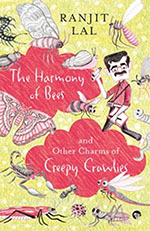A freely roaming centipede in the bathroom or a happy family of lice in our hair is the stuff of nightmares and feverish dreams. In horror, we often ask, ‘Why on earth do we need a mosquito?’ As it is with mother nature, there is always an answer. Turns out, there would be no life on earth without these seemingly disgusting and terrifying little beings. Biologist and Naturalist EO Wilson rightfully called them, ‘the little things that run the world’.
In The Harmony of Bees, Ranjit Lal takes us on a friendship journey with twenty different insects and arachnids, making them less fearful and more intriguing on the way. These include some ubiquitous ones like ants, bees and spiders, and others like bugs, wasps and mantis that one finds only on careful looking. An introduction, afterword and a two-page glossary towards the end further supports the chapters.
The book begins with and carries a sombre acknowledgement. Insects are scary, yes, but they are also our neighbours on this planet. While we go to great lengths to protect ourselves from them, it is we who pose a bigger threat. ‘Mostly however, creepy crawlies leave us alone. In turn, we rob them of the fruits of their toil and take advantage of their love lives to grow crops and use them to turn waste into rich, fruity soil.’
Each chapter illustrates the short lives of these creepy crawlies, highlighting their physical features, food, hunting habits, procreation and the irreplaceable role they play in maintaining the delicate ecological balance. A master storyteller, Ranjit is able to make each insect a protagonist in the earth’s story. In the chapter on wasps, he writes, ‘The tiny fig wasp makes pretty sure that no banyan tree can have a bloated ego.’
Lal’s writing is fast paced and attractive, quickly pulling the reader in. True to his characteristic lightness, and sureness about everything nature, he is also able to highlight the drama that ensues in each of their lives, leaving out any prospects of a boring read.
‘Sometimes, dung-beetle couples work together; while the husband rolls the ball, the wife shouts directions and encouragement and helps if he has to push it up a slope. They have to be snappy, because other dung beetles are only too ready to snatch and grab.’
A matter-of-fact, lively and contemporary use of language further adds to the engagement. Much of the context to each chapter comes from the author’s own observation, subtly encouraging curiosity and observation in readers as well. ‘A spider once built a small web in the corner of my bathroom, virtually at floor level. I thought she was nuts—nothing would come her way. But she’d figured it out.’
Non-fiction books have long been imagined as dusty, dry reference books at the far end of the library. In India, they are typically equated with encyclopaedias and quiz books, attributed solely to facts. This makes non-fiction a slippery genre, with a fine line existing between a good non-fiction and a text-book. The Harmony of Bees is authentic, readable and engaging, making it an exemplary piece of non-fiction and nature-writing. This is the book that might lead someone to house a beetle in their pencil box.
November 2023, volume 47, No 11

